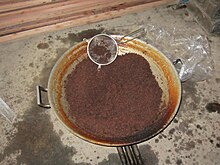Latik
 | |
| Type | Dessert topping |
|---|---|
| Place of origin | Philippines |

Latík (Tagalog:
Visayan Latik
Latík in its original sense in the
It is used much in the same way as syrup, in dishes like kalamay and suman.[5] It is usually Anglicized as "coconut caramel."[1] A commercial version of the Visayan latik is marketed internationally as coconut syrup, though it should not be confused with coconut sugar derived from coconut sap.[6][7]
Tagalog Latík
Latík in Luzon is made from coconut milk simmered in a saucepan until it reduces to coconut oil and solids ("coconut curds") begin to form at the top surface. These solids are left to fry in the coconut oil until golden brown.[8][9] In the Visayas, these solids are known as lunok in Cebuano; and balutai in Karay-a.[10]
Latík is commonly used as topping for a variety of Philippine dishes including maja blanca, sapin-sapin, and ube halaya.[11][12]
They are sometimes mistaken for fried caramelized coconut flesh (another type of garnishing/dessert known as
See also
- Kalamay
- Coconut jam
- List of condiments
- List of dessert sauces
- List of Philippine dishes
- Maglalatik (literally "latik maker"), an indigenous Philippine dance
- Philippine condiments
References
- ^ ISBN 9780199313396.
- ^ "latik". Binisaya.com. Retrieved July 5, 2011.
- ^ "Bisaya translation for "latik"". Bisaya Translator and Cebuano Dictionary. Archived from the original on August 11, 2013. Retrieved July 5, 2011.
- ^ "Philippine quarterly of culture and society". 32. University of San Carlos. 2004: 31.
{{cite journal}}: Cite journal requires|journal=(help) - ^ "Suman Latik". Lutong Bahay. Retrieved July 5, 2011.
- ^ Thampan, Palakasseril Kumaran (1981). Handbook on Coconut Palm. Oxford & IBH. p. 199.
- ISBN 9789251008539.
- ^ a b "Latik / Fried Coconut Milk Solids". Market Manila. August 5, 2008. Retrieved July 5, 2011.
- ^ Vanjo Merano (March 25, 2010). "How to Make Latik". Panlasang Pinoy. Retrieved July 5, 2011.
- ISBN 9786214200870.
- ISBN 978-962-593-245-3.
- ISBN 978-971-10-1241-0.)
{{cite book}}: CS1 maint: multiple names: authors list (link

